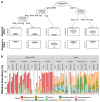Seed Imbibition and Metabolism Contribute Differentially to Initial Assembly of the Soybean Holobiont
- PMID: 38818306
- PMCID: PMC7616048
- DOI: 10.1094/PBIOMES-03-23-0019-MF
Seed Imbibition and Metabolism Contribute Differentially to Initial Assembly of the Soybean Holobiont
Abstract
Seed germination critically determines successful plant establishment and agricultural productivity. In the plant holobiont's life cycle, seeds are hubs for microbial communities' assembly, but what exactly shapes the holobiont during germination remains unknown. Here, 16S rRNA gene amplicon sequencing characterized the bacterial communities in embryonic compartments (cotyledons and axes) and on seed coats pre- and post-germination of four soybean (Glycine max) cultivars, in the presence or absence of exogenous abscisic acid (ABA), which prevented germination and associated metabolism of seeds that had imbibed. Embryonic compartments were metabolically profiled during germination to design minimal media mimicking the seed endosphere for bacterial growth assays. The distinction between embryonic and seed coat bacterial microbiomes of dry seeds weakened during germination, resulting in the plumule, radicle, cotyledon, and seed coat all hosting the same most abundant and structurally influential genera in germinated seeds of every cultivar. Treatment with ABA prevented the increase of bacterial microbiomes' richness, but not taxonomic homogenization across seed compartments. Growth assays on minimal media containing the most abundant metabolites that accumulated in germinated seeds revealed that seed reserve mobilization promoted enrichment of copiotrophic bacteria. Our data show that seed imbibition enabled distribution of seed-coat-derived epiphytes into embryos irrespective of germination, while germinative metabolism promoted proliferation of copiotrophic taxa, which predominated in germinated seeds.
Keywords: Bacillus; Buchnera; Glycine max (soybean); Rhodococcus; abscisic acid; imbibition; metabolism; microbiome; seed germination.
Conflict of interest statement
The author(s) declare no conflict of interest.
Figures







Similar articles
-
Tailored Media Are Key to Unlocking the Diversity of Endophytic Bacteria in Distinct Compartments of Germinating Seeds.Microbiol Spectr. 2022 Aug 31;10(4):e0017222. doi: 10.1128/spectrum.00172-22. Epub 2022 Jul 18. Microbiol Spectr. 2022. PMID: 35867396 Free PMC article.
-
Shading of the mother plant during seed development promotes subsequent seed germination in soybean.J Exp Bot. 2020 Mar 25;71(6):2072-2084. doi: 10.1093/jxb/erz553. J Exp Bot. 2020. PMID: 31925954 Free PMC article.
-
Role of seed coat in imbibing soybean seeds observed by micro-magnetic resonance imaging.Ann Bot. 2008 Sep;102(3):343-52. doi: 10.1093/aob/mcn095. Epub 2008 Jun 19. Ann Bot. 2008. PMID: 18565982 Free PMC article.
-
A seed coat bedding assay shows that RGL2-dependent release of abscisic acid by the endosperm controls embryo growth in Arabidopsis dormant seeds.Proc Natl Acad Sci U S A. 2010 Nov 2;107(44):19108-13. doi: 10.1073/pnas.1012896107. Epub 2010 Oct 18. Proc Natl Acad Sci U S A. 2010. PMID: 20956298 Free PMC article.
-
Seed microbiomes promote Astragalus mongholicus seed germination through pathogen suppression and cellulose degradation.Microbiome. 2025 Jan 24;13(1):23. doi: 10.1186/s40168-024-02014-5. Microbiome. 2025. PMID: 39856709 Free PMC article.
Cited by
-
Non-rhizobial endophyte recruitment and diversity in Pisum sativum are strongly shaped by phosphorus fertilizer form.Environ Microbiome. 2025 Jul 21;20(1):92. doi: 10.1186/s40793-025-00751-0. Environ Microbiome. 2025. PMID: 40696482 Free PMC article.
References
-
- Abdelfattah A, Tack AJM, Lobato C, Wassermann B, Berg G. From seed to seed: The role of microbial inheritance in the assembly of the plant microbiome. Trends Microbiol. 2023;31:346–355. - PubMed
-
- Abdelfattah A, Wisniewski M, Schena L, Tack AJM. Experimental evidence of microbial inheritance in plants and transmission routes from seed to phyllosphere and root. Environ Microbiol. 2021;23:2199–2214. - PubMed
-
- Adam E, Bernhart M, Müller H, Winkler J, Berg G. The Cucurbita pepo seed microbiome: Genotype-specific composition and implications for breeding. Plant Soil. 2018;422:35–49.
-
- Alibrandi P, Cardinale M, Rahman MM, Strati F, Ciná P, de Viana ML, Giamminola EM, Gallo G, Schnell S, De Filippo C, Ciaccio M, et al. The seed endosphere of Anadenanthera colubrina is inhabited by a complex microbiota, including Methylobacterium spp. and Staphylococcus spp. with potential plant-growth promoting activities. Plant Soil. 2018;422:81–99.
-
- Archer E. rfPermute: Estimate permutation p-values for random forest importance metrics. 2022. https://cran.r-project.org/web/packages/rfPermute/rfPermute.pdf .
LinkOut - more resources
Full Text Sources
